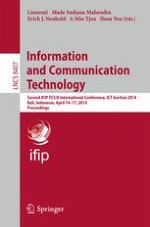This book constitutes the refereed proceedings of the Second IFIP TC 5/8 International Conference on Information and Communication Technology, ICT-Eur Asia 2014, with the collocation of Asia ARES 2014 as a special track on Availability, Reliability and Security, held in Bali, Indonesia, in April 2014. The 70 revised full papers presented were carefully reviewed and selected from numerous submissions. The papers have been organized in the following topical sections: applied modeling and simulation; mobile computing; advanced urban-scale ICT applications; semantic web and knowledge management; cloud computing; image processing; software engineering; collaboration technologies and systems; e-learning; data warehousing and data mining; e-government and e-health; biometric and bioinformatics systems; network security; dependable systems and applications; privacy and trust management; cryptography; multimedia security and dependable systems and applications.
